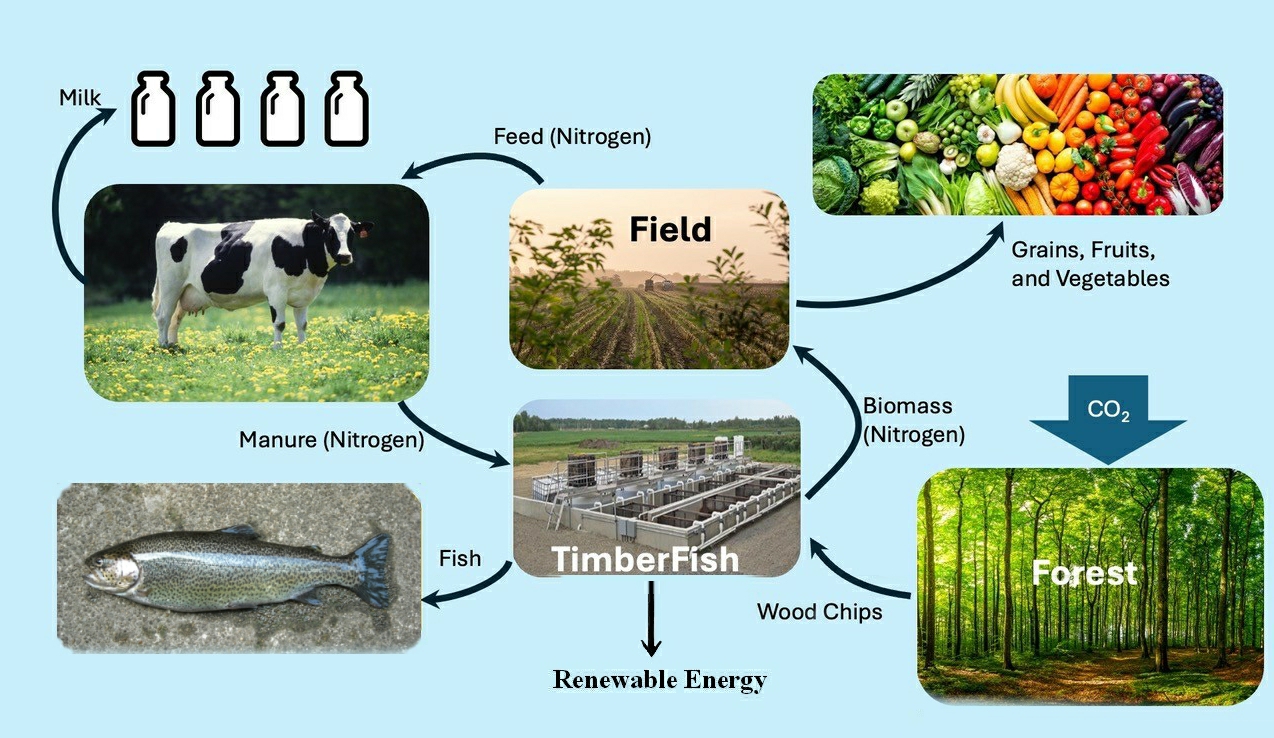Ecologically Integrated Agriculture
Ecologically Integrated Agriculture (EIA) is a new form of comprehensive agriculture that combines; animal agriculture; animal feed, grain, fruit, and vegetable farming; aquaculture; and forestry. This is all tied together by the TimberFish Technology (TFT), as shown in this diagram designed by Leland Beaumont, which clearly and eloquently illustrates the essential concepts of EIA. This represents the best in ecological thinking in that it fosters a way of thinking that considers all aspects of a situation in an intuitive and natural way.
Here all of the agricultural systems mentioned above are interrelated by following the role of how nitrogen acts within each system and how it is transferred between systems. The application illustrated here focuses on dairy cows as a source of manure, and forests as a source of nitrogen. It should be noted here that while dairy cows are used in this example the process is equally valid for other types of manure producing systems. These include beef, hogs, poultry, sheep, goats, or Recirculating Aquaculture Systems. It also can apply to many other food or beverage production or processing operations including distilleries, breweries, and wineries.
In this schematic, a cow is in a Confined Animal Feeding Operation (CAFO) at a large dairy farm. The TimberFish system takes all of the manure from the dairy, combines it with wood chips from a forest, and generates a microbial biomass. As a part of this process some of the wood chips are consumed by the microbes. Some of this microbial biomass is then eaten by invertebrates which in turn are then eaten by fish. Thus fish become a product of the EIA TimberFish system.
Some of the remaining partially degraded wood chips can be mixed with the remaining microbial biomass and applied to fields. This generates feed for the cows, and grains, fruits, and vegetables for us. The rest of the partially degraded wood chips can be used to generate renewable energy. This occurs because the residual wood chip has a greater lignin content than raw wood chips do, and hence they have an elevated energy content. In many cases this can power all of the energy needs for the entire EIA system while also exporting some energy to the surrounding community.
There are many advantages to this EIA system. First, it eliminates the necessity to spread manure on land for its fertilizer value. Such land application often generates offensive odors and the emission of greenhouse gases to the atmosphere. If not done properly it can also cause nutrient pollution of ground and surface waters.
Second, it generates a large and new source of locally produced, contaminant free seafood. This provides a new source of animal protein in the form of fish, shrimp, mollusks, etc. raised in land based Recirculating Aquaculture Systems.
Third, the microbial biomass provides for a slow release, odor free, certifiably organic fertilizer that can be used in many different types of applications. These range from use for growing feed crops for the dairy or other animal operations, to application to orchards, gardens, grain fields, and landscaping.
Fourth, it requires large amounts of forested land. This generates new income for that land, and provides an economic incentive for new forest development, reforestation, and deforestation avoidance. All this occurs because the amount of wood chips removed from forested land each year for TimberFish is less than the total amount of new carbon sequestered by that forested land each year. Thus the whole integrated system becomes a major driver for mitigating and reversing Climate Change.
Fifth, it is a source of renewable energy and this allows it to make all of the included processes sustainable because they no longer have to rely on fossil fuels or other external energy sources to operate.
